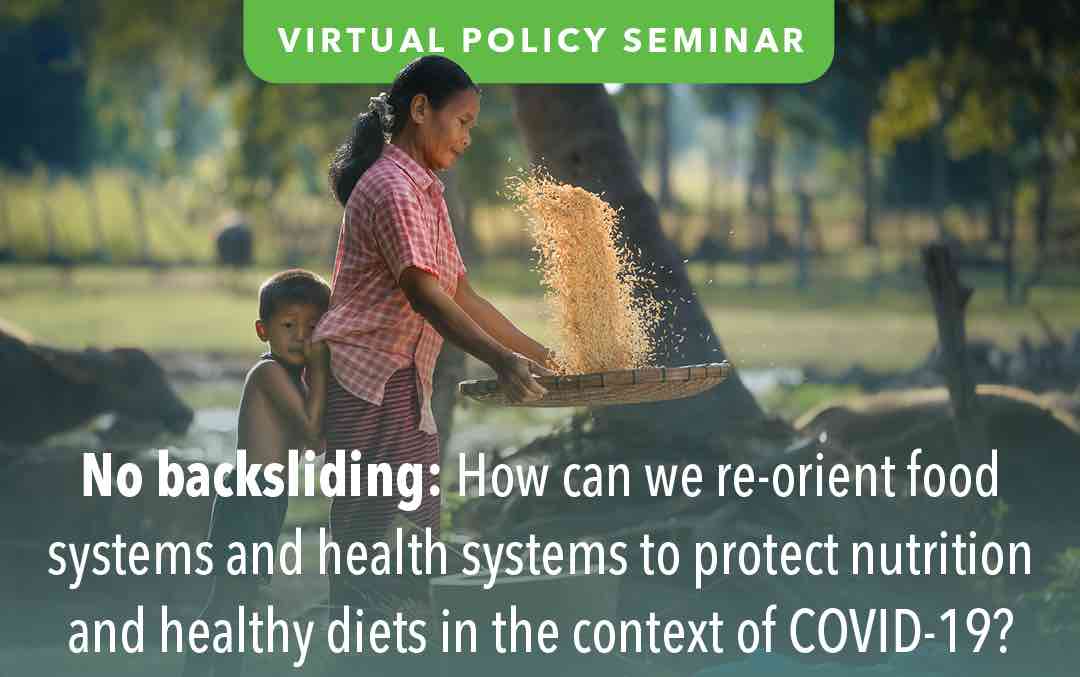Policy seminar: No backsliding – reorienting food and health systems to protect nutrition in a global pandemic
- From
-
Published on
17.07.20
- Impact Area

By Janet Hodur
The COVID-19 pandemic—and the resulting economic crisis and disrupted food and health systems—will likely severely worsen all forms of malnutrition globally. In the short to medium term, micronutrient deficiencies, child wasting and stunting, and overweight and obesity are all expected to surge, stemming the tide of recent progress toward achieving the World Health Assembly’s 2025 Global Nutrition Targets.
What impacts can we anticipate, particularly for maternal and child nutrition, nutrition interventions, and mortality? What adaptations can help rebuild stronger health, economic, and food systems, protecting nutrition and healthy diets moving forward? A May 28 virtual policy seminar cohosted by IFPRI and the CGIAR Research Program on Agriculture for Nutrition and Health (A4NH) explored these questions.
The global community now faces a “perfect storm for nutrition,” with impacts on every form of malnutrition, said Marie Ruel, Director of IFPRI’s Poverty, Health, and Nutrition Division. “The current crisis is affecting all of the systems we are relying on for improving nutrition,” Ruel said, including health, social protection, water, sanitation, and food systems.
As health care workers are reassigned to focus on COVID-19, there are fewer available to focus on essential nutrition actions, Ruel said, including antenatal care, childbirth, immunization, and micronutrient supplementation, as well as preventing and treating malaria and other diseases that have impacts on nutrition. In addition, many people are afraid to go to health centers because they fear being exposed to the coronavirus, leading to drops in demand for basic health and nutrition-related services.
Current economic challenges also threaten to make nutrition matters worse. Ruel cited IFPRI research that projects an additional 140 million people worldwide could fall into poverty this year alone, alongside projected declines in consumption of nutritious yet more costly items such as fruits, vegetables, and animal source foods as people try to maintain their caloric intake on reduced budgets.
Information beginning to come in from phone surveys echoes this, with Bangladesh reporting declines in food expenditures accompanying declines in income, and disruptions in food supply chains from changing demand and supply impacting Ethiopia. The pandemic has also disrupted social protection programs around the world, with implications for nutrition. For example, school feeding programs struggle to come up with alternate strategies that still provide nutritious food in light of widespread school closures.
Ruel recommended a number of actions to protect nutrition: Keeping food systems functioning, including the informal sector; facilitating innovations to improve access to nutrient rich foods, including stimulating demand and addressing misinformation; protecting basic health services and social safety nets; and focusing on vulnerable groups and inequalities. “The crisis is exacerbating all of the inequalities in age, gender, for refugees, the poor,” and other vulnerable groups, she said.
Robert Black, Director of the Institute for International Programs at the Johns Hopkins University (JHU) Bloomberg School of Public Health, zeroed in on the pandemic’s indirect effects on children in low- and middle-income countries (LMICs). While COVID-19 child mortality rates appear to be quite low, he said, children will be disproportionately affected by disrupted routine health services and rising food insecurity.
Related news
-

Australia partners with International Livestock Research Institute to upskill researchers from Africa and Asia
International Livestock Research Institute (ILRI)13.11.25-
Food security
-
Poverty reduction, livelihoods & jobs
Australia has joined forces with the International Livestock Research Institute (ILRI) to support th…
Read more -
-

Next-gen rice lines top check varieties at 7.5 t/ha in ESA
International Rice Research Institute (IRRI)11.11.25-
Food security
MOROGORO, Tanzania (8 October 2025) — Elite rice lines are outperforming the current popular varie…
Read more -
-

QTL Profiling Now Live on EBS
International Rice Research Institute (IRRI)11.11.25-
Food security
QTL profiling is now integrated into the EBS Platform’s MDA module. Teams across CGIAR research…
Read more -
